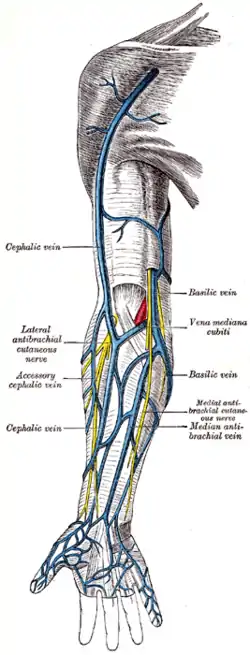Median cubital vein
In human anatomy, the median cubital vein (or median basilic vein) is a superficial vein of the upper limb.[1] It is very clinically relevant as it is routinely used for venipuncture (taking blood) and as a site for an intravenous cannula.[2] This is due to its particularly wide lumen, and its tendency to remain stationery upon needle insertion.[2] It connects the basilic and cephalic vein and becomes prominent when pressure is applied. It lies in the cubital fossa superficial to the bicipital aponeurosis.
| Median cubital vein | |
|---|---|
 Superficial veins of the upper limb. The median cubital vein is labelled (in Latin) - Vena mediana cubiti. | |
| Details | |
| Source | cephalic vein |
| Drains to | basilic vein |
| Identifiers | |
| Latin | vena mediana cubiti |
| TA98 | A12.3.08.019 |
| TA2 | 4980 |
| FMA | 22963 |
| Anatomical terminology | |
Variations
The median cubital vein shows a wide range of variations. More commonly, the vein forms an H-pattern with the cephalic and basilic veins making up the sides.[3] Other forms include an M-pattern, where the vein branches to the cephalic and basilic veins.[3]
Additional images
 The most frequent variations of the veins of the forearm (schematic).[3]
The most frequent variations of the veins of the forearm (schematic).[3]
- Dissection images
 Median basilic vein
Median basilic vein
See also
References
- Standring, Susan. Gray's anatomy: the anatomical basis of clinical practice (41 ed.). Elsevier Limited. pp. 837–861. ISBN 978-0-7020-5230-9.
- Lew, K. (2012-01-01), Pawliszyn, Janusz (ed.), "3.05 - Blood Sample Collection and Handling", Comprehensive Sampling and Sample Preparation, Oxford: Academic Press, pp. 95–121, doi:10.1016/b978-0-12-381373-2.00068-5, ISBN 978-0-12-381374-9, retrieved 2020-11-17
- Pires, L.; Ráfare, A. L.; Peixoto, B. U.; Pereira, T. O. J. S.; Pinheiro, D. M. M.; Siqueira, M. E. B.; Vaqueiro, R. D.; de Paula, R. C.; Babinski, M. A.; Chagas, C. A. A. (2018-06-01). "The venous patterns of the cubital fossa in subjects from Brazil". Morphologie. 102 (337): 78–82. doi:10.1016/j.morpho.2018.02.001. ISSN 1286-0115.
External links
- Anatomy photo:07:st-0703 at the SUNY Downstate Medical Center
- Radiology image: UpperLimb:18VenoFo from Radiology Atlas at SUNY Downstate Medical Center (need to enable Java)